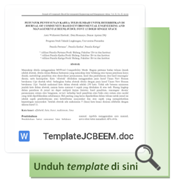Determination of Tebing Keraton Recreation Demand Functions With Travel Cost Method
DOI:
https://doi.org/10.23969/jcbeem.v6i1.5346Keywords:
multiple linear regression, recreation demand functions, Tebing KeratonAbstract
Forest recreation services as additional products that are intangible. It can not be quantified because it does not have a price on the normal market system. It underlies a study to determine the economic value of recreation, with case studies Tebing Keraton using the Individual Travel Cost Method. Analysis of data obtained from questionnaires using data processing equipment SPSS version 21 with multiple linear regression method to get the Tebing Keraton recreation demand functions. The variables that influence the number of visits are travel cost, total income, age, mileage, and gender. Coefficient values of variables determine the trend in increasing or decreasing the number of tourist visits. In this study, the demand functions divided into two recreational functions for students/scholar and for working people considering total income per month category. Based on the regression results, demand functions for students/scholar, is Y=-2.179–0.0000347X1+0.286X2+0.159X3-0.0000794X4-0.267X5, and for working people is Y=1.994–0.00000164X1+0.53X2-0.32X3-0.003X4-0.334X5. The regression result obtained a coefficient of determination (R2) that the percentage of the diversity of demand number of visits to Tebing Keraton which can be explained by the independent variables in the model. R2 value of model for students/scholar is 67.1%, which is more than 0.5, showing the moderate accuracy. While for working people, the value of R2 is 48.9%, which is in the range of 0.31 – 0.5, indicate the weak accuracy.
Downloads
References
Armadinata, R., & Pharmawati, K. (2019). Valuasi Nilai Ekonomi Wisata Pantai Sawarna Dengan Menggunakan Travel Cost Method. Journal Of Community Based Environmental Engineering And Management, 3(2), 49-56. doi:10.23969/jcbeem.v3i2.1835
Czajkowski, M., Giergiczny, M., Kronenberg, J., and Englin, J. The Individual Travel Cost Method with Consumer-Specific Values of Travel Time Savings. Environmental and Resource Economics, 74: 961-984.
Gravitiani, E. (2010). Aplikasi Individual Travel Cost Method Di Area Publik. Jurnal Ekonomi dan Studi Pembangunan, 11(1): 30-37.
Gujarati, D. (2007). Ekonometrika Dasar. Penerbit Erlangga. Jakarta.
Henseler, J., Ringle, C., and Sinkovics, R. (2009). The use of partial least squares path modeling in international marketing. Advances in International Marketing (AIM), 20: 277-320.
Isyala, R., & Pharmawati, K. (2019). Pengembangan Pengelolaan Sistem Persampahan Area Wisata Grama Tirta Jatiluhur Menggunakan Prinsip Contingent Valuation Method. Journal Of Community Based Environmental Engineering And Management, 3(2), 57-64. doi:10.23969/jcbeem.v3i2.1836.
Jala, Nandagiri, L., (2015). Evaluation of Economic Value of Pilikula Lake using Travel Cost and Contingent Valuation Methods. Aquatic Procedia, 4: 1315-1321.
Juanda, B. (2007). Metodologi Penelitian Ekonomi dan Bisnis. IPB Press. Bogor.
Muthmainnah, M., Tahnur, M. (2018). Nilai Manfaat Ekonomi Hutan Kota Universitas Hasanuddin Makassar. Jurnal Hutan dan Masyarakat, 10(2): 239-245.
Novianti, D., Palasara, N., Qomaruddin, M. (2021). Algoritma Regresi Linear pada Prediksi Permohonan Paten yang Terdaftar di Indonesia. Jurnal Sistem dan Teknologi Informasi, 9(2): 81-85.
Syaleh, H. (2020). Pelatihan Program Statistic Product and Service Solution (SPSS) bagi Mahasiswa dan Dosen Sekolah Tinggi Ilmu Ekonomi H. Agus Salim Bukittinggi. Community Engagement & Emergence Journal, 1(1): 14-21.
Wibowo, M., Abidin, Z., & Marlina, L. (2021). Economic Valuation With Travel Cost Method (Tcm) Slanik Waterpark South Lampung District. Journal Of Community Based Environmental Engineering And Management, 5(1), 1-8. doi:10.23969/jcbeem.v5i1.3359
Yulian, E.N., Syaufina, L., Putri, E.I.K. (2011). Valuasi Ekonomi Sumberdaya Alam Taman Hutan Raya Bukit Soeharto Di Provinsi Kalimantan Timur. JPSL, 1(1): 38-46.
Yustiani, Y.M., Emilia, E., & Permana, A. (2019). Kajian Valuasi Ekonomi Wana Wisata Taman Hutan Berdasarkan Pendapat Masyarakat Pengunjung. Journal Of Community Based Environmental Engineering And Management, 1(1), 1-9. doi:10.23969/jcbeem.v1i1.1366














